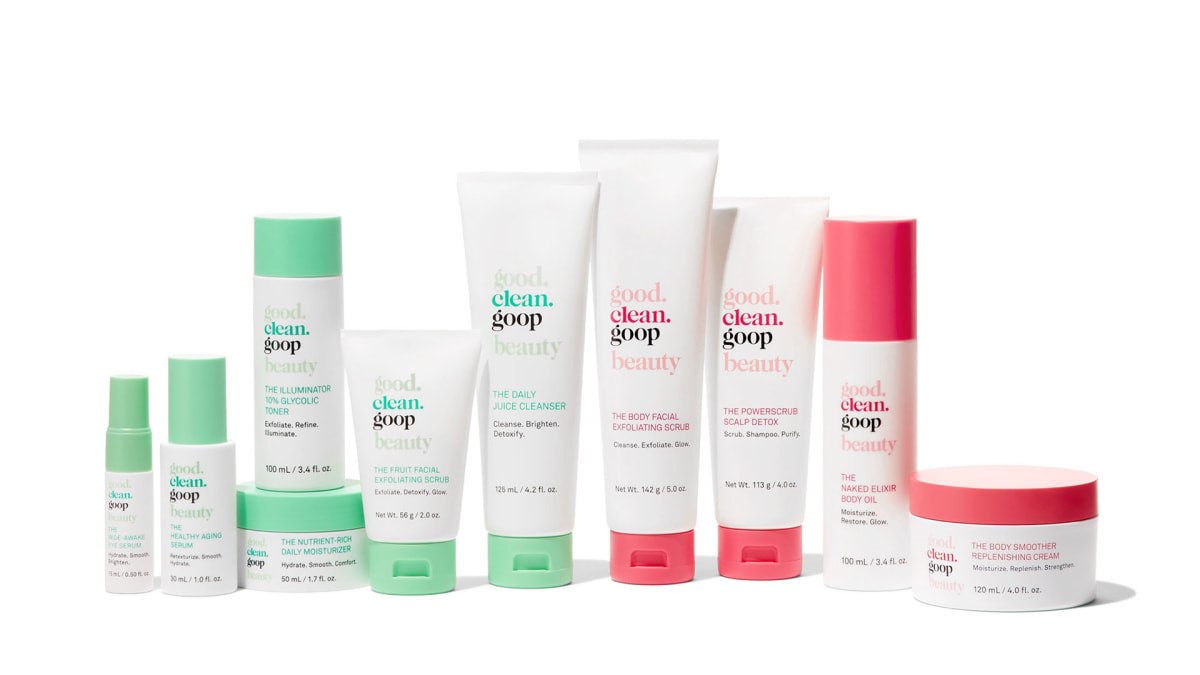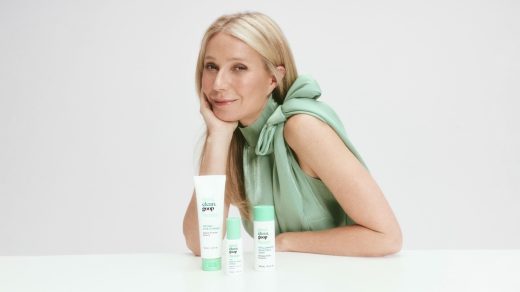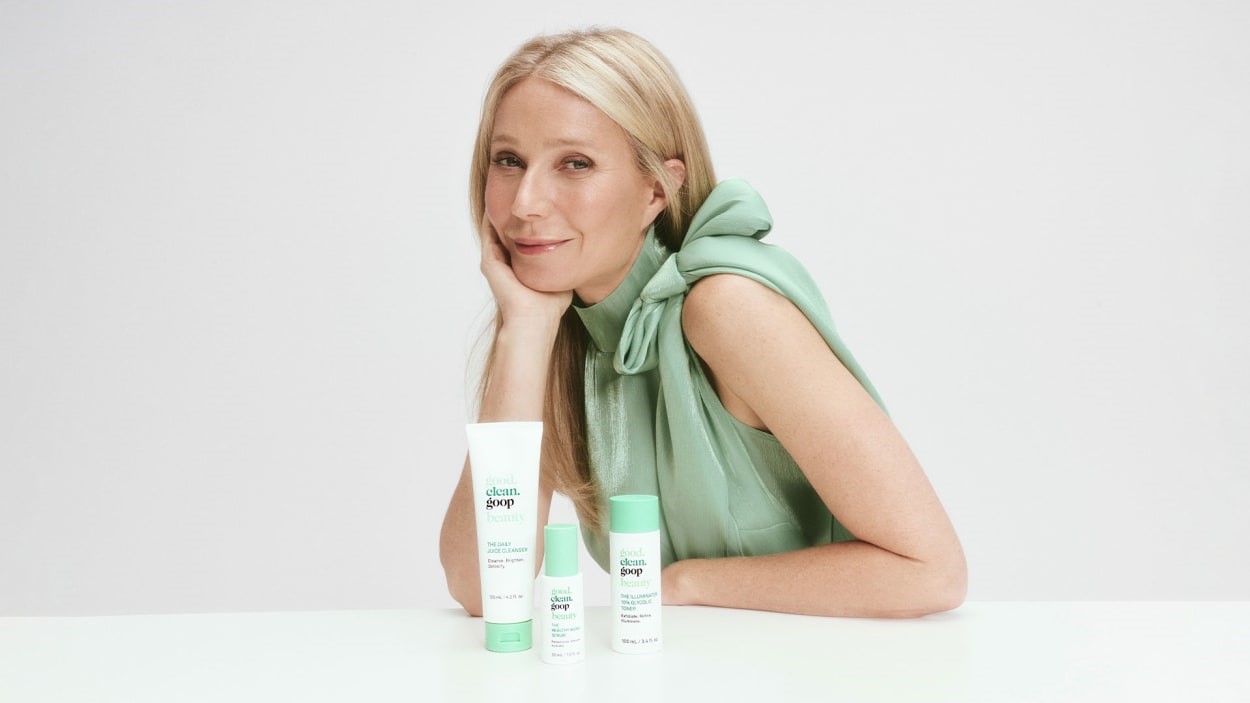Can Goop go mass market with a new skincare line at Target and still be . . . Goop?
By Yasmin Gagne
Goop is stepping down off its pedestal. Today, the lifestyle brand hits Target aisles and Amazon virtual shelves with good.clean.goop, a 14-piece skincare and supplement line. (Don’t worry, no jade eggs in sight.) Unlike Goop’s primary skincare line, which is sold on its eponymous site for prices that can run as high as $150, each piece in the good.clean.goop collection retails for under $40.
The move is raising some eyebrows. After all, Goop founder and CEO Gwyneth Paltrow has spent 15 years building a famously out-of-touch and wildly aspirational brand, one that promises customers that with enough money they, too, can live like she does. (Who can forget Paltrow’s personal style—The Row sweaters, Smythson notebook, etc.—on display during her infamous ski trial.) Could offering a cleanser for just $19.99 on the shelves of a mass-market (albeit style-conscious) retailer like Target puncture the brand’s quietly luxurious veneer?
Before thinking about how good.clean.goop fits into Goop’s overall business, it’s worth considering what Goop actually is. A sprawling number of business ventures and partnerships have launched under the Goop moniker. The site, which started as a blog filled with product recommendations from Paltrow, soon evolved to marry content and commerce: An article like “How to Organize Your Beauty Cabinet Like a Pro” includes some 24 product recommendations, all of which are sold on the site.
But by 2012, Goop was making its own products. And today it sells its own lines of clothing, jewelry, kitchenware, home goods, beauty products, and sex toys (naturally). The uniting themes? Minimalism, eco-consciousness, and indulgence.
The company, which isn’t yet profitable, according to a recent report from Puck, has raised $70 million from the likes of Lightspeed Ventures. (The last round was in 2018.) To reach its lofty $250 million valuation, Goop has had to expand.
In addition to selling ads and branded content on its site, Goop has launched a variety of side hustles over the years. It experimented with publishing, creating a magazine with Condé Nast until a dispute over fact-checking led Goop to go it alone. It has partnered with Celebrity Cruises on a Goop Cruise and Airbnb on a stay in Paltrow’s guesthouse. There’s been a Goop show on Netflix. Last year, Goop launched Goop Kitchen, a delivery-only restaurant brand, available in Los Angeles. The company operates five brick-and-mortar retail stores in upscale locations in California, New York, and Hawaii, and boasts a thriving events business.

Enter good.clean.goop. “We waited a long time to do a diffusion line because we really wanted to establish Goop as an efficacious prestige line across fashion, jewelry, and a lot of other verticals,” Paltrow says. “If you look at a brand like Ralph Lauren, there’s a price differential and positioning between their Ralph Lauren Collection and the licensed pillowcases you would find at Bloomingdale’s.”
Paltrow points out that Target has had many successfull collaborations with high-end designers, including Missoni, La Ligne, and Rachel Comey. The good.clean.goop products, she says, are well-reformulated but retail for a lower price than Goop’s signature skincare line because they don’t contain as many active ingredients. (Much like a high-end designer might work with more affordable fabrics for a Target capsule collection.)
While Goop has a strong brand, Target has the power to introduce it to an entirely new cohort of shoppers, says Forrester analyst Sucharita Kodali. “I don’t think most people even know what Goop is other than a few Gwyneth Paltrow either superfans or haters. This is a great way for the brand to be in a major mainstream store,” she says.
If the products are popular—and the Goop branding resonates—shoppers may eventually upgrade to other, more expensive offerings from the brand. And skincare seems like a good bet: Goop’s skincare line made up 64% of the company’s sales on its site in 2022.
Paltrow also points to consumer data from Goop. Many of the site’s customers might aspire to the Goop lifestyle, but not all of them are wealthy. “We have seen in the past that certain SKUs that we sell that are more accessibly priced, like lip balm or our jelly cleanser, do really well. The appetite for lower-priced products is certainly there.”
But Paltrow is spreading her bets. Asked about any other upcoming collaborations, she stays mum, saying only, “It’s my dream to index more into home. I love furniture. I would love to have a Goop wellness hotel someday, you know, these are like big pipe dreams. With me you never know, I do tend to try these crazy things.”
(30)



